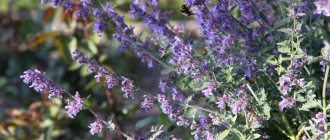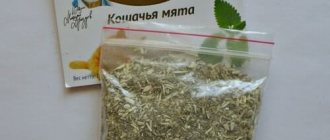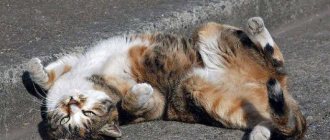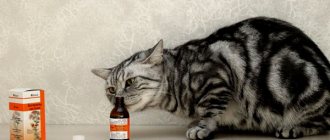Catnip affects the behavior of cats, causing agitation and some degree of aggression. Moreover, the reaction is typical for the entire cat family, that is, for wild species.
The thing is that the herb contains a special compound - nepetalactone, which, when inhaled, affects the brain centers. Interestingly, excitation of the nervous system in response to the entry of the compound into the body occurs only in sexually mature individuals.
The effect of the plant lasts about 15 minutes, gradually weakening, while the cat’s behavior is similar to the period of sexual heat, which is why the grass is called an artificial pheromone.
Description of catnip
Catnip is a perennial herb. It has a straight stem with down, 50 to 100 cm long. The heart-shaped leaves have edges with pronounced serrations. The flowers are light purple or lilac. The smell is vaguely reminiscent of citrus fruits, namely a lemon aroma. Externally, the herb looks like ordinary mint or lemon balm.
The flowering period, as a rule, begins in early summer, and by the end of August the fruits appear - small brown nuts. The plant contains many essential oils.
Error . Taking Iron Blindly
In terms of absorption, iron is a particularly capricious microelement. It should be taken with particular caution. The point is not even that the drug in drops stains tooth enamel. Excess iron is deposited in internal organs (liver, pancreas, thyroid gland), leading to serious disorders: hemochromatosis, cirrhosis, hepatitis, melasma (dusty bronze skin color).
Iron is poorly absorbed with dairy products and coffee.
On the contrary, vitamin C, B12, and folic acid contribute to the favorable absorption of iron.
If iron is poorly absorbed, the doctor prescribes special complexes
.
How does catnip work on cats?
As we have already said, the stimulating effect of catnip is due to the active substance of the herb - nepetalactone. When animals inhale mint essential oils, this compound contained in them interacts with specific transporter proteins. Subsequently, because of this, the centers of the brain are activated - the amygdala and hypothalamus, which are regulators of the emotional behavior of cats. Stimulation of the centers leads to a change in the pet’s behavior such as sexual hunting. That is, catnip essential oils act on the same principle as pheromones. At the same time, the pet exhibits motor activity, varying degrees of aggression, meows loudly, looks excited and restless. The behavioral reaction of cats to valerian is formed in a similar way.
However, not every cat is susceptible to catnip. The appearance of a response to a plant depends on genetic characteristics. Approximately 30% to 50% of pets (according to various sources) lack the gene locus that is responsible for the perception of aroma, that is, nepetalactone does not interact with the carrier protein, and, therefore, there is no reaction from the central nervous system.
Impact on the body
The mechanism of action of catnip is based on its effect on the nervous system of both cats and humans. It's all about the substance produced, nepetolactone. This chemical process is unusual, so scientists began to study it ( 1).
British scientists have discovered that the substance produced by the plant is suitable not only for treating and calming the nervous system. It can be used in other compounds, and its spectrum of action is so broad that it could help in the discovery of cancer drugs.
Long-term study of catnip has led scientists to the conclusion that the volatile substances it produces have completely unexpected and atypical properties. At the moment, scientists are trying to determine how the plant produces a drug so strong for cats in order to learn how to synthesize it to produce completely new and more effective drugs.
If we consider the plant exclusively for animals, scientists have proven that cats’ craving for it is due to protection from mosquitoes. When exposed to catnip, the animal's susceptibility to insect bites decreases ( 2).
Uses of catnip
The main application is to correct the behavioral characteristics of cats. If the cat is phlegmatic, then the grass will allow him to show playfulness and improve overall physical and emotional activity.
The plant is often used to transport animals when moving or traveling. This is needed to stabilize the emotional background and reduce stress.
Also, with the help of the smell of plants, they accustom a cat to a scratching post or tray:
- To train him to use the litter tray, place a few catnip leaves next to the litter box. The smell helps to attract your pet's attention. However, it is worth changing the plant several times a day, because essential oils disappear quickly.
- If you need to accustom your cat to a scratching post, you need to rub its surface with catnip. Your pet will also be attracted to the scent.
It is important to note that experts do not recommend using catnip or valerian for litter box training, etc., as there is a risk that the cat will not use it in the future. Veterinarians draw the attention of owners to the fact that a cat can be raised without additional funds, the main thing is to be patient.
Sometimes the dried plant is placed in a bag and thus made into a toy with which the cat is more willing to play.
If your pet refuses to eat, it is recommended to add a small amount of dry crushed grass leaves to the food bowl.
Veterinarians say that catnip has a calming effect on the digestive tract - it reduces the motility of the stomach and intestines. Therefore, it is recommended to use it in cases of simple food poisoning or exacerbations of chronic diseases. However, do not abuse it under any circumstances.
According to some reports, catnip helps with helminthiasis. However, this has not been proven.
The grass is not addictive.
The listed methods of using mint only affect mature cats, since kittens under the age of six months do not react to the active substances of catnip.
When using a purchased plant-based product, it is recommended to carefully read the attached instructions for use. High doses are harmful to your pet.
Which one is better to choose?
It is recommended to purchase catnip from trusted sources. This guarantees reliability and quality. These resources include the IHerb , where you can purchase not only medicines, but also dietary supplements, pet products, cosmetics and much more.
In order to purchase goods on the site, registration is required. After it, your personal account appears with a list of promotions, a shopping cart and a wish list. Discounts and promotions are not uncommon, so in many cases you can save a lot of money.
All IHerb products are of natural origin. To make it more convincing, there are many reviews from real people. If there is no clear goal, it is recommended to go to the “Popular” section. Delivery is carried out throughout the country, by courier or self-pickup.
As for catnip, you can find a large list of different products on the website. These are drugs for adults, children, supplements for cats, medicines for animals.
Contraindications
In addition to the benefits, the plant also causes harm:
- Veterinarians do not recommend the use of catnip if the pet is showing severe aggression. High activity of the central nervous system leads to neurological disorders as a result of depletion of the neurotransmitter system.
- It is forbidden to give grass to cats during pregnancy. Stimulation of the nervous system has a negative effect on the condition of the future offspring, and can also provoke premature birth or miscarriage.
It is important to consider that regular long-term use of the plant causes dangerous conditions in cats.
Salty taste in mouth
This is the first sign of dehydration. When a person drinks little water or takes diuretics, the fluid in the body thickens. It’s the same with saliva – salty sodium chloride accumulates in it. Or maybe you're just eating too much salty food - chips, crackers, salty sticks?
If the problem is related to dehydration, drink at least 1.5-2 liters of clean water per day, and in the heat - another 1 liter. At the same time, give up alcohol, including beer. Avoid drinking coffee, tea, energy drinks and weight loss shakes. All of these drinks have diuretic properties.
Very often, a salty taste occurs when the salivary glands are blocked. Then you will need to visit a dentist.
A salty taste in the mouth is a sign of dehydration.
Growing and storing catnip
Burda can be grown at home. It is best in a flowerbed or in a vegetable garden, but it is also possible indoors, for this you need a large pot.
After preliminary germination of the seeds in the pot, the plant is planted in the soil. For normal growth, a sufficient amount of sunlight is necessary, so do not choose shady areas.
The plant reaches 50-100 cm in height. In mid to late summer, leaves and flowers are collected and used for medicinal purposes, as a seasoning, and to correct pet behavior.
The collected herbs are dried in a dry, dark place. The shelf life is one year. Cultivation does not require frequent care or special conditions.
Sour-salty taste
This symptom may be a warning of chronic or acute kidney failure, a condition in which the kidneys do not work properly and the body cannot eliminate toxins from the body. In severe cases of renal failure, a taste appears and the smell of the mouth changes. You may smell urine.
In addition to these symptoms, weakness, weight loss, loss of appetite, nausea and vomiting warn of the development of chronic renal failure and irreversible damage to the body. The person becomes drowsy, headaches and muscle pain occur.
Chronic renal failure
A urologist can diagnose kidney failure. To do this, you will need to take blood and urine tests and examine your kidneys. In some cases, you even need to do a biopsy.
Why do people need catnip?
Due to its rich content of beneficial substances, catnip has found use in alternative medicine. It has anti-inflammatory, antiseptic and antibacterial effects.
- Compresses and lotions made from this herb are often used to treat skin diseases and acne. An antiseptic decoction of the leaves fights suppuration on the skin.
- Also, with the help of catnip, diseases of the digestive tract are treated.
- Mint has a beneficial effect on the blood coagulation system, thereby stopping bleeding.
- Another advantage is the reduction of blood pressure in hypertension.
- The use of herbal decoctions and extracts helps fight insomnia.
- Mixing lemon balm or peppermint and catnip is used for inflammatory processes - menthol has an analgesic effect, and essential oils soothe the lesion.
The beautiful color of the flowers and ease of care are a plus when planting in the ground. Therefore, the plant is used in landscape design. In addition, catnip is a perennial plant. This feature allows you not to replant mint every year.
The pronounced lemon smell is used in cooking as a spice. The plant is added to pies, pastries, and cakes.
1111
How to Grow Catnip at Home
At home, growing catnip by seed has proven to work best.
Monstera flower - what the plant and leaf look like
To do this, you need to take a seedling box or any suitable container. This species will “like” the most nutritious soil. Although a self-prepared soil mixture and a purchased universal substrate will differ in composition.
You can take: 1 part peat, 1 part turf soil, 2 parts nutrient soil and 1 part charcoal. Catnip will grow best in pre-disinfected soil. This can be done by ordinary calcination or by moistening the soil with a weak solution of potassium permanganate.
Step-by-step instructions for growing in a pot
To improve germination, pre-soak the seed material.
On a note! Soaking the seeds can be combined with their simultaneous processing. If you immerse the seed in manganese for 10-15 minutes, this will not only disinfect them, but also significantly increase germination.
The sequence of actions taken should be as follows:
- Before planting, the soil is moistened;
- the seeds are planted in the soil no deeper than 1 cm. At this stage, it is important to follow the sowing pattern to avoid crowding of plantings. The distance between seedlings should not be less than 5 cm;
- the next stage is re-wetting the soil. Spraying with a spray bottle is best suited for these purposes;
- An important condition for good germination is the creation of a “greenhouse effect.” To do this, you can put a transparent bag on the container or cover it with any transparent material;
- When the first shoots appear, the lid must be removed;
- after the formation of true leaves, the plantings are picked;
- transplanting young seedlings into individual pots should be accompanied by pinching the roots. Thanks to this procedure, the plant will grow in a horizontal rather than vertical direction;
- moving to larger containers is carried out as the catnip grows.
It is important to remember that for the health of the plant it is important not only to comply with planting rules, but also to timely and high-quality care of the seedlings.
In order to prevent the soil from drying out, a tray is installed under the pot, which is filled with water as needed. It is advisable to carry out timely formation of the plant. When side shoots and leaves are removed, the flower will begin to develop upward more actively.
Growing catnip at home
Important! The pinching and pruning procedure should be carried out only after the end of the flowering process.
We must not forget about the necessary feeding of plantings. Any natural mineral preparations are suitable for these purposes. The first time fertilizer is applied to the soil at the moment the first shoots appear. The second - before the formation of inflorescences, the third - during active budding and the appearance of the first flowers.
If you do not fertilize the soil in a timely manner, the roots of the flower will be depleted and the catnip will not be able to develop.
What is it, what does it smell and look like - description, photo
Catnip (from the Latin Népeta catária) is a plant that the cat family is partial to . It has several other names, also called catnip or lemon catnip.
In appearance and smell, a person can easily confuse it with lemon balm. A cat will never make a mistake. This is an unusual plant with woody roots. The plant reaches a height of 40 -100 cm. The stem is straight, not bending. The leaves are heart-shaped with large teeth.
Flowers bloom at the ends of stems and branches. Most often, the flowers are off-white with lilac spots. They have smooth, oval-shaped fruits.
How is it different from regular and other types?
The difference between catnip and ordinary catnip has long been known; it is the difference in the essential oils that are included in its composition. There are many types of mint and below we will look at a few of them.
| Plant height | Essential oil | Application | Habitat | |
| Cat mint | from 40 – 100 cm | Nepetalactone |
|
|
| Peppermint | from 30 – 100 cm | Menthol |
| Gardens |
| Lemon Balm | from 30 – 120 cm | Citral |
|
|
| Homemade mint | from 20 – 60 cm | Pulegon |
|
|
There are quite a lot of differences between catnip and other species; some types of mint are used in medicine, and some even in perfumery .
How much does it cost and where to buy
Catnip is a fairly tenacious and popular plant in Russia, sold in many pet stores and gardening nurseries. In special stores for animals, this grass is already sold in the form of a spray or dried, packaged in bags for ease of use.
Often, you can find ready-made toys for cats labeled catnip, which means that there is dried mint inside the toy.
In dry form, stores ask for 150-180 rubles for 15-20 grams of the plant; the spray will cost more - about 350-400 rubles per 100 ml, but it is much more convenient to use.
Where does catnip grow?
Cat mint grows wild in forests and fields of the Russian Federation; the plant is especially popular in the northern part of the country. Cultivated types of grass can be found in the design of borders in the city.
Since the esters of this plant cause attacks of euphoria in most cats, around it you can find flocks of animals rubbing against flowers and leaves. In this case, it is better not to let your pet close to the plant, since you can get many diseases and parasites from other cats.
Benefits and harms for humans
pros
- It is used to combat insomnia not only in adults, but is also absolutely safe for babies.
- Eliminates feelings of anxiety.
- Help with intestinal spasms.
- Improves blood circulation.
- Clearing the lungs of phlegm.
- Relieves stomach pain.
- Eliminates flatulence.
- Acts as an antiseptic.
- Used for asthma.
- Helps with both diarrhea and constipation.
- Oral administration is used as an anthelmintic.
- Ingestion prevents skin diseases.
To improve digestion, for gastritis and other unpleasant issues associated with the gastrointestinal tract, take catnip decoction orally.
- 1 hour required. l. Dried grass pour a glass of boiling water and leave for 3 hours.
- Strain the resulting infusion and take 1 tbsp before meals. 3 times a day.
For colds, the decoction should be taken orally hot.:
- For 500 ml. You will need 1 tbsp boiling water. l. dried herb.
- Infuse for 20-30 minutes and can be drunk as tea with raspberries or honey.
- Be sure to strain before use.
Minuses
It should not be used for food or for treatment in cases of individual intolerance, also for pregnant and lactating women.
What attracts cats to mint
One of the main compounds of catnip is nepetalactone, which is found in the leaves, flowers, and stems of the plant. It is its characteristic smell that cats like so much.
Nepetalactone is a natural attractant (flavor) - a substance that causes animals to be attracted to the source of smell.
To experience euphoria, a cat must smell mint. Felines have 2 olfactory organs. One by one, the smell penetrates the nasal cavity, then, passing through a layer of mucus, reaches the olfactory receptors. Then the signal goes to the brain.











